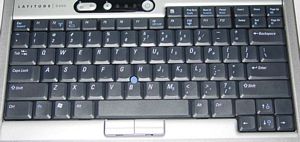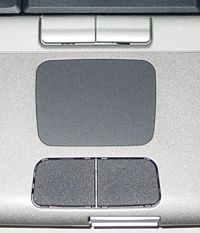Mid-sized Dothan Notebook Roundup: Dell, Gateway, and HP/Compaq
by Andrew Ku on September 30, 2004 1:09 AM EST- Posted in
- Laptops
Dell Latitude D600: In the Field
FanThe unit's CPU fan is on only when it needs to be, as it is initiated at a particular thermal point. So, as CPU usage goes up, the fan will in turn be activated or fan speed will be increased. There does seem to be variable degrees in the fan speed, but even with the fan at maximum speed, it is only seems to be on for a few seconds. At that max speed, the noise is very distinguishable. At mid-speed, you would actually need to be in a room that is quiet enough to hear the second hand of a clock in order to make out the low pitched hum of the CPU fan. In a reasonably quiet room, where you could hear a pin drop, you need to be within about 5" of the laptop to distinctly make out the fan; and probably within 2" of the left side of the laptop to make out the fan's buzz sound. Actually, if the optical drive is being accessed, the fan's noise will be drowned out.
Heat
In our opinion, there doesn't seem to be an issue with heat for these notebooks. In field use, the top of the system stays pretty cool to the touch; but on the bottom, only the left side of the system (where the CPU is located) gets warm. Though, it only gets hot enough to serve as a lap/hand warmer. It is definitely tolerable.
Keyboard
Compared to the other two systems in this roundup, we would have to say that this is the middle child, in terms of keyboard quality, but it is still better than what we usually see. Compared to the Inspiron line, it has better feedback, but it seems to have a shorter "click", which is the best way we can describe it.
The control key and function key are located in the correct spot: control key at the bottom left corner with the function key to the right of it. We were pleased to see that Dell continued to provide dedicated page up, page down, home and end keys, but it may be hard for those with small hands to reach while centering on the arrow keys.
TouchPad & Buttons
We can't distinctly put our finger on whether or not we like this touchpad. Generally speaking, the touchpads on business notebooks are different than their consumer counterparts, just like the keyboard selection. This is because business users tend to expect a higher quality keyboard/touchpad in their laptop systems, a premium that they expect to pay over consumer notebooks.
However, it has been a while since we had a Dell Latitude in the labs.
The D600's touchpad, compared to those on most other notebooks, is quite sensitive. It has a better glide aspect, in our opinion. Perhaps this is due to the fact that most other notebooks have touchpads with lower degrees of sensitivity. This is going to be one of those "like it or love it" features. You can still tweak the sensitivity of the touchpad, but there is a general sense of this touchpad, particularly its texture, that is different than others which we have used. So, it is a bit of both hardware and software related.
The buttons for the touchpad have a particular click to them that is similar to that of our Logitech M-BJ69 USB optical mouse, though it is a lengthier click. This is different from most other notebooks (including the other two in this roundup), in which the norm has been for touchpad buttons to have a shallower or less "clicky" feel. When using the buttons on the D600, you can clearly hear the click of the buttons. You don't really get that with other notebooks.
We should note that this is a dual input system, as Dell implements a touchpad and TrackPoint. Our personal preference is to use TrackPoint and its buttons over the touchpad system for the D600.












23 Comments
View All Comments
Monkeydonutstick - Thursday, September 30, 2004 - link
You can't be serious about comparing a Powerbook G4 to any of these. Powerbooks were owned by P3’s for Christ sake.plewis00 - Thursday, September 30, 2004 - link
I just wanted to point out as an nc6000 user that you didn't mention it's speakers (which as any Compaq user will know) are some of the best on any laptop - very rich with reasonable bass and strong volume, it easily rivals small stereos.Secondly, I don't think it's quite clear how much tougher the HP is than the Dell. I had both and pressing slightly on the Dell logo on the D600 would flex it down by about 3-4mm with very little pressure; the HP is far more robust, so it's size isn't that much of an issue (but the Dell is a bit of a headturner, the HP definitely isn't).
Also (only a small point) but given the Dell's and HP's graphics cards, a small 3D-based test (3DMark2001 SE?) wouldn't have gone amiss [that's the reason I had these machines for their size and graphics]. In seriousness, with that Gateway, what are you going to do with a 1.7Ghz Dothan CPU if not game sometimes, or that you couldn't do with a Pentium III-M 850Mhz?
manno - Thursday, September 30, 2004 - link
ksherman- "wheres the Macs? As far as im concerned, the Powerbook owns all these in terms of performance, size, weight, looks, and battery life... Its apparently even in the same price range as these "mid-sized" laptops... Bring on the Mac articles AT!"I have no clue about the technical aspect of the powerbooks size, weight, and battery life. But I do know you couldn't be more right about the looks... PLUS there's a Quake I... and I think a Quake II software renderer for Macs also... nudge nudge wink wink.
manno - Thursday, September 30, 2004 - link
SOFTWARE renderer origianl "Half-Life" or "Quake 2". Preferably Half-Life. Their software reneder is more taxing than Quake 2's. Old school, yes, but it's not biased tward desktop, or laptop video cards.peace on!... Crakers!
AndrewKu - Thursday, September 30, 2004 - link
#4 - Hopefully, we will get to that real soon.AndrewKu - Thursday, September 30, 2004 - link
#6 - Well, I hope we didn't knock it too much in the overall sense. But we are talking about the business user market segment, and we were putting more emphasis on the display more so than the other nic nacs.YaBaBom - Thursday, September 30, 2004 - link
I'm not a Gateway fan, but I think it's kind of silly to knock the Gateway laptop in the ratings because it doesn't have gigabit ethernet. Gigabit ethernet is nothing but a sales pitch as far as laptops are concerned, since the hard drives just arent capable of supplying data at gigabit speeds. I can tell you from experience that a D600 with gigabit doesnt transfer any faster than a C640 with 10/100 ethernet.brainwave64 - Thursday, September 30, 2004 - link
Great review! Very informative. It's hard to find good reviews of laptops that take into account things other than performance - like ergonomics, LED locations, battery life, weight, size, etc.--paperboy164
ksherman - Thursday, September 30, 2004 - link
wheres the Macs? As far as im concerned, the Powerbook owns all these in terms of performance, size, weight, looks, and battery life... Its apparently even in the same price range as these "mid-sized" laptops... Bring on the Mac articles AT!AndrewKu - Thursday, September 30, 2004 - link
#1 - A64 based laptops, at least so far, are those best reserved for the DTR market, and thus are focused on the performance aspect of the notebook market. If you want mobility, get a P-M based notebook.As for half-life or other gaming applications, one of these notebooks uses Intel's integrated graphic's system, so that wasn't something that was practical, and of the other two that use discrete GPUs, one uses a DX8 mobile graphics part.
#2 - Well... As far as weight and the general specs go, I think the whole market is becoming more and more grey. We will be back with a thin and light side of the Dothan market.